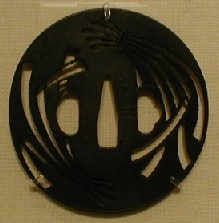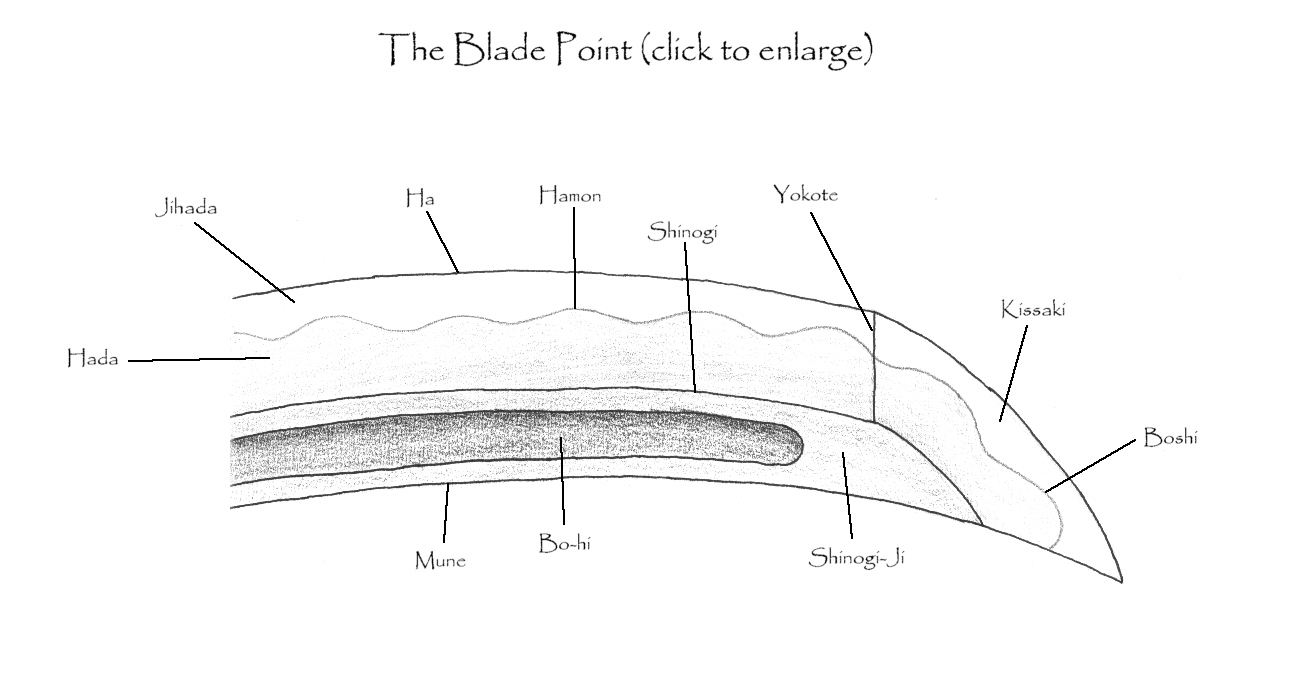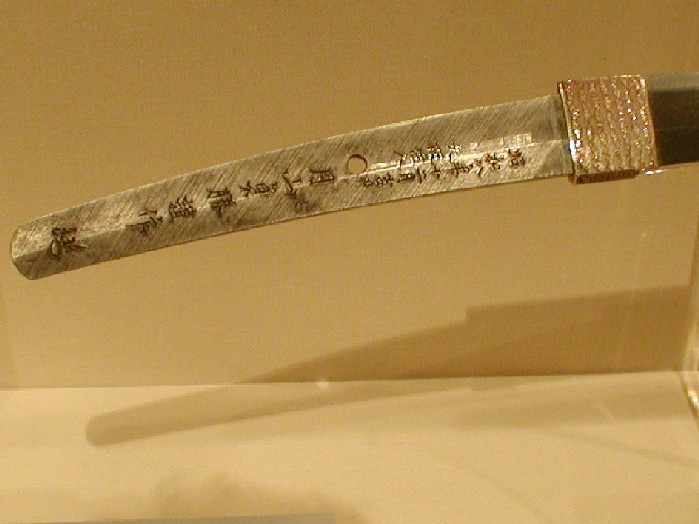
This section includes a comprehensive list of all the parts of a samurai sword. The parts listed below are for a Katana, since this is the most common form of Japanese sword. It is worth noting that a true katana has every single one of the features listed below (apart from the bo or bo-hi which are optional), a sword which omits some of them is not a true katana, although it can still be a good practice blade. Other swords are made from the same parts, apart from the exceptions noted under their respective headings. The other swords included in this section are Wakizashi, Tanto, Tachi and No-Dachi. The information is split into three sections, The Tsuka (Handle), The Blade, and The Saya (Scabbard).For general descriptions of each type of sword, please refer to the Types of Sword section.
Please click to enlarge any of the pictures on this page
Katana
The Tsuka (Handle)
Nakago (Tang) – This is the part of the sword blade that fits into the handle of the sword. Unlike the rest of the blade, it has no edge and is left unpolished. The nakago has a number of features including the mei, the mekugi-ana and the yasuri-me.
Ho (Bamboo Handle) – The Ho is made up of two pieces of bamboo shaped to fit snugly around the nakago leaving no gaps showing. They feature a slot at the bottom for the kashira and a hole which lines up with the mekugi-ana on the nakago.
Mekugi (Bamboo Peg) – The mekugi is a small bamboo peg which is tightly driven through the holes in the ho and nakago to prevent the handle from falling apart. Some swords have two pegs for extra strength.
Same (Handle Wrap) – The same is formed from several strips of material placed on the ho, or rarely, one large piece wrapped right around it. It provides a 'background' which will show through the traditional diamond-shaped gaps in the tsuka ito. The traditional material for the same is ray-fish skin (although the word ‘same’ actually means shark in Japanese), although since this material is quite rare, many of the lower-end modern swords used for Iaido feature less expensive synthetic alternatives.
Menuki (Ornament) – The menuki come in pairs and usually feature a very elaborate design. In some swords, they are simply flat metal ornaments held in place by the tsuka ito. Some inexpensive practice swords even omit them altogether, or only have one (a common feature of cheap replica swords). However, the menuki are a traditional part of the sword, and technically, a sword without them cannot really be called a true katana. They are usually made of cast iron, but examples of silver, bronze and multiplate (combinations of several metals) menuki can also be found.
Tsuka Ito (Handle Braid) - The tsuka ito is a characteristic feature of most types of Japanese sword, and is the most defining feature of the handle. The braid is made from several long strips of material wrapped in an intricate pattern around the same. Traditionally the pattern leaves diamond-shaped gaps through which the same and menuki can be seen. The tsuka ito fulfils several purposes. Firstly it helps hold the whole handle together, including the menuki, which it overlaps. Secondly it provides the handle with a good grip, which is an essential feature of any sword. The material is traditionally tightly wound silk, but many modern practice Iaito come with a cheaper cotton substitute.
Fuchi (Metal Collar) - The Fuchi is a metal collar adorned with intricate patterns which fits tightly onto the very top of the ho. It provides additional ornamentation for the handle, and holds the ho together in one piece. It is made from the same material as the menuki, although multiplate fuchi are extremely rare, so an alternative is often used when a sword is fitted with a multiplate menuki.
Kashira (Pommel Cap) - The Kashira fits into the slot at the bottom of the ho, and fulfils exactly the same functions as the fuchi, except at the other end of the handle. Fuchi and Kashira almost always come in a matching pair. Some styles of kashira feature a hole that the tsuka ito can be threaded through for extra security. Many samurai also threaded coloured ribbons through these holes.
1st Seppa (spacer) - The first seppa is a small ring of metal, fitted immediately above the fuchi and below the tsuba. It usually features a simple design such as a rope or winding ivy stem. To the casual observer, it looks like part of the fuchi. Its purpose, in conjunction with the second seppa is to hold the tsuba in place.
Tsuba (Sword guard) - The tsuba is the guard at the top of the handle. Tsubas are usually circular in shape, but some examples are square, hexagonal or even octagonal. The tsuba is the most ornate feature of the sword, and the intricate designs on them often tell a story. Tsubas have become collectible items in their own right, and some people have extensive collections. It is even possible to buy display rack specifically designed to hold tsubas. Click here to view the Tsuba Gallery.
2nd Seppa (spacer) - The second seppa is identical to the first in every way. It is fitted above the tsuba and below the habaki, and in conjunction with the 1st seppa, holds the tsuba in place.
The Blade
Sori (Curve) – The sori is not a physical part of the blade, but is rather the measurement of it’s curvature. It is the greatest distance between the back of the blade and an imaginary line drawn from the mune-machi to the very point of the sword, measuring perpendicular to this line. The extremity of the sori has a pronounced effect on the effectiveness of the blade. It is generally accepted that a curved blade is better than a straight one. A curved weapon cuts more naturally, is easier to pull out of a corpse (if you’ll forgive this gruesome example, it is a weapon after all!), and it easier to draw and sheath. A curvature means the weapon can only be single edged, but as any swordsman will tell you, it is natural to cut with only one edge of a sword anyway, so this is not a great disadvantage. Another interesting implication of the curvature is that it means that the sword must contain more material to give it the same length and reach as a straight-bladed weapon. This means a sword with a high curvature will be heavier than another which is exactly the same, but has a low curvature. The result of this is that a high curvature makes blows more powerful, but at the cost of speed. A low curvature means the opposite is true. A moderate sori is considered best as it gives a good balance between power and speed.
Habaki (ferrule) – the habaki is a straight-edged metal sleeve which fits at the very top of the handle where it meets the blade. It is not part of the blade when it is forged, but is added afterwards. The habaki touches the ha-machi and mune-machi and sits flush with both the edge (ha) and back (mune) of the blade. The size of the habaki exactly corresponds with the size of the hole in the koiguchi (mouth of the saya/scabbard). It is essential that the habaki is the right size in order to provide a tight friction fit when the sword is sheathed. This ensures that the sword will not fall out of the saya unintentionally. This could be very embarrassing in the training hall, and potentially lethal on the battlefield!
Hi (Groove) - The hi is an optional feature of the blade. It is a deep grove in the shinogi-ji on both sides of the blade. It runs approximately 1/4 the length of the blade. It's effect is very interesting. Contrary to popular opinion, it is not a blood groove, but instead a performance adjustment to the weapon. The addition of a hi to the sword means there is less material in the blade due to the groove. This means that the sword is lighter, making it's blows less powerful, but making the weapon slightly faster and easier to wield. For this reason, hi are rarely used in Tameshigiri, but are highly sought after in swords intended for use in Iaido. Historically, the presence or absence of a hi gives an indication of the fighting style of the samurai who used it in battle.
Bo-hi (Full-length Groove) - The Bo-hi is a variant on the hi, which runs the full length of the blade. Obviously, this has almost quadruple the effect of a hi, making the sword very light, but quite a bit less damaging. Thus, these swords are very rarely used in Tameshigiri, because they simply do not have the weight behind them needed to cut effectively. The Bo-hi also gives another interesting effect. When the sword is swung true (the back and front of the blade directly in line with the direction of the cut), the groove causes the air to hiss loudly around the blade. This, in addition to the lightness it gives the blade, makes it ideal for Iaido, as you can instantly tell whether or not the cut you just performed was true.
Nakago (Tang) – Although already mentioned as part of the handle, the nakago is essentially a part of the forged blade, so I will also include it here for completeness sake. The nakago is the part of the sword blade that fits into the handle of the sword. Unlike the rest of the blade, it has no edge and is left unpolished. The nakago has a number of features including the mei, the mekugi-ana and the yasuri-me.
Mei (Signature) – The mei is an inscription on the tang of the blade that displays the name of the smith who forged the blade. Obviously, just like signatures on paintings, the mei of a famous smith can add thousands of pounds to the value of the sword. However, also like paintings, signatures of famous smiths are often forged to add value to blades. In addition, most mei include only the family name of the smith, which can cause additional complications. The rigid caste system of medieval Japan meant that it was commonplace for a son to follow in his father’s footsteps and take the same trade. Therefore, what appears to be the mei of a legendary blademaker could in fact be the mei of a great-grandson who had little of his ancestor’s skill. Reading and understanding mei is almost an art in its own right. If you intend to buy a sword which is claimed to be made by a famous smith, it is well worth finding an expert who can check the sword out to make sure (please do not e-mail me about this, I am NOT an expert in identifying swords).
Mekugi-ana (Peg hole) – The mekugi-ana is a hole in the tang through which the mekugi is inserted. Most blades have one mekugi-ana, whilst some have two, allowing two pegs to be used for additional strength.
Yasuri-me (File Marks) – The Yasuri-me are file marks on the tang, either across the mekugi-ana or just above it. There are many different styles of Yasuri-me, some quite simple, others more complex. The purpose of Yasuri-me is a complete mystery to me, I have never seen anything which suggests why they are present. If you know anything about this, please contact me, any information will be gratefully received.
Ha-machi (Front Notch) – The ha-machi is a small notch on the front of the blade which marks the beginning of the tempered edge of the sword. It protrudes slightly from the nakago, but when the habaki is in place, forms a straight edge.
Mune-machi (Back Notch) – The mune-machi is exactly opposite the ha-machi on the blade, and marks where the tempered part of the blade begins. Like the ha-machi, it protrudes slightly, but the habaki covers this and the notch is not visible when the sword is fully assembled. The length of the blade is measured from the Mune-machi to the very point of the sword, in a straight line through the air, not accounting for the curvature of the blade.
Horimono (Carving) - The horimono is a intricate carving on the shinogi-ji close to the mune-machi. Often it is a design which ties in with the designs on the rest of the katana, although it can also sometimes be in writing. It is entirely optional, but still quite common in historical examples, although very rare in modern swords.
Ha (Edge) - The cutting edge of the sword
Jihada (Edge Steel) - The sloping steel on each side of the blade which meets to form the cutting edge.
Hamon (Temper Line) - The hamon is the line formed when the blade is tempered. It is hard to see when the weapon is first forged, but is revealed clearly after polishing. The hamon is a distinctive feature of a katana, and adds to the beauty of the blade. The shape of the hamon is decided by the swordsmith who makes the blade, and there are many different kinds of hamon, all which have their own name.
Hada (Midsection) - The middle part of the blade which gently slopes upwards towards the Shinogi.
Shinogi (Ridge Line) - The line which separates the the Hada and and Shinogi-ji
Shinogi-ji (Flat Section) - The flat ridge at the back of the blade.
Mune (Back) - The back of the blade.
Yokote (Point Line) - The line which separates the point from the rest of the blade.
Kissaki (Point) - The angled end part of the cutting edge which forms the point of the blade.
Boshi (Temper Line) - The Boshi is the name given to the part of the hamon which covers the Kissaki. Just like the hamon, there are many different kinds, and their shapes are independent of the hamon shapes, although similar shapes are usually chosen for the two of them.
The Saya (Scabbard)
Saya (Scabbard) - Although used collectively as a term for the whole scabbard, the word Saya also refers just to the main wooden part of the sheath onto which the other fittings are added. The saya is made from two pieces of sturdy wood (not bamboo), glued together and decorate with a fine laquer. The patterning on the saya can be highly decorative, or just a single colour.
Koiguchi (Scabbard Mouth) - The part of the scabbard into which the blade is inserted. The hole in this matches exactly with the habaki to provide a tight friction fit. The Koiguchi is often highly ornamented and is constructed from metal.
Sageo (Cord) - The sageo is a cord wrapped around the upper part of the saya. It provides a grip for the saya, and is a traditional part of the katana fittings. There are many different styles of knot for tying the sageo.
Kurikata (Knob) - The Kurikata has two purposes. Firstly, the sageo is wrapped around it to make sure the knot stays in place. Secondly, it catches against the obi (belt) helping to prevent the whole saya sliding out of the obi when the sword is drawn.
Kojiri (Scabbard Tip) - The Kojiri is a ornamental metal fitting at the very end of the scabbard. It is an optional fitting, but in my opinion, it really compliments the rest of the saya, and makes the whole sword look more complete.
The Wakizashi is comprised from exactly the same pieces as the Katana, except it's sori (blade curvature) is lower, and the blade, handle and saya are shorter.
Again, identical to the Katana, except for length and curvature. Tanto always have straight blades and frequently have no tsuba.
Identical to the Katana, but much larger.
Top: No-Dachi blade
Bottom: Naginata Blade
The Tachi is similar to the Katana, except for the differences noted here:
The Tsuka
The tsuka of a Tachi is shorter than a Katana tsuka, and is designed for one-handed use.
Kabuto-Gane (Pommel Cap) - Simply a slightly larger version of the kashira, with a different name.
O-Seppa (Large Spacers) - A larger version of the Seppa found on a Katana.
Tsuba (Sword Guard) - Same as a Katana Tsuba, but slightly smaller and often square in shape.
The Saya
The following parts are not found on a Tachi saya:
Sageo
Kurikata
Koiguchi (present on inside of saya, but not visible when sword is sheathed)
A Tachi Saya is made and decorated in the same fashion as a Katana saya, but also often features small circular designs repeated down the length of the saya (if you know the name of these, please contact me)
The following parts are exclusive to the Tachi saya:
Saya Ito (Scabbard Wrap) - Similar to the tsuka ito, but covering approximately 1/3 the length of the saya. Provides a good grip when unsheathing the weapon.
Ashi (Hangers) - The ashi are two ornamented hangers made from metal and silk. They are used to hang the tachi from the obi (belt) of the wearer.
Semegane (Scabbard Ring) - A small, decorative ring of metal approximately 2/3 of the way down the saya.
Sayajiri (Scabard Tip) - The name given to a more rounded version of the kojiri found on katanas.






